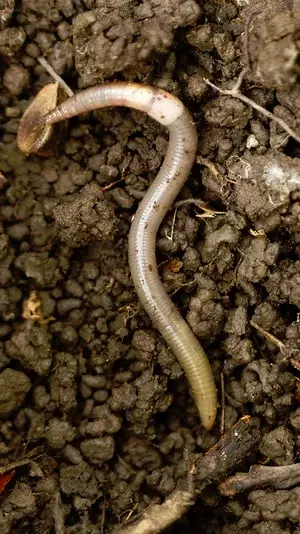With the departure of the Winter that wasn’t, Ontario gardeners have two new invasive environmental threats to watch for; the Hammerhead worm, and the Asian Jumping worm. Although these worms are not native to Ontario, they have been spotted in the province have the potential to be destructive, in very disparate ways.
On one hand, the first worm species to consider is native to Southeast Asia and secretes a neurotoxin that may result in tingling or rashes when touched.
The other worm is originally from East-Central Asia and can cause damage to soil as it quickly can reproduce and out-compete worm and bugs that are beneficial to soil quality, leaving it degraded. It has been reported that some of these worms can jump as much as a foot into the air.
The ‘cannibalistic’ Hammerhead Worm
Jessica Fugard, a St. Thomas resident, indicates that she is well acquainted with worms citing her life as the daughter of a fisherman, and correspondingly having handled many as a result.
However, Fugard admitted that the sight of a Hammerhead Worm in her garden this April was an eye-opener as she had never seen one before.
“At first, honestly, it looked like a leech, because you could see that it was flat (and) it was moving really slow,” she recalls. “When I found it, it was actually eating a snail.”

Excited by the discovery, Fugard took some pictures and attempted to capture it.
“I went inside … to go find something to grab it with, came back out and it was gone,” she said.
A short video of the worm posted to a gardening group on social media has garnered close to 4,000 views.
Fugard has since reached out to the Invasive Species Centre (ISC) to spread the word to fellow growers of the worm’s existence.
“It’s not every day that you get to discover something … that should be talked about.”
Up till now, the ISC has received roughly half dozen reports of hammerhead worms province-wide, including discoveries in Hamilton, Newmarket and Woolwich.
Dr. John Warren Reynolds is a laboratory biologist who has been studying various worm species for more 55 years. Dr. Reynolds says the Hammerhead is considered to be invasive in some regions of the world where they have been identified.
The Hammerhead, which is also known as bipalium or broadhead planarian, has a line that produces a neurotoxin known to be destructive to nerve tissue.
Reynolds stated that the chemical, which is typically found in worm slime, can cause human fingers to tingle or to breakout in a rash when touched.
In the cases in which pets and children have ingested these worms, the effects have been more profound often resulting in hospitalization.
“If you mistakenly ingest some or part of it … they can make you nauseated, but they aren’t necessarily fatal,” Reynolds explained.
Often described as cannibalistic, this predator is shown to attack the very useful earthworms, slugs and snails which is, consequently, very destructive to the ecology they infest.
“They’re also cannibalistic, so if they don’t find those other things, they can eat other worms if they find them,” said Reynolds.
Gardeners who discover one is recommended to don a pair of gloves, grab the worm and to store it in a plastic bag, and to leave it in the hot sun.
In typical scenarios, the species can be eliminated with exposure to temperatures of 40 C (104 F).
Reynolds indicated that currently there is no pesticide shown to eradicate the worms and that cutting them will not be effective as the hammerhead can regenerate and even multiply.
“The interesting thing about this group of worms is if you chop them up into a dozen pieces, each piece will grow into a new individual,” according to Reynolds.
Asian Jumping Worm may be bigger problem
Reynolds is suggesting, however, that another worm that has been identified in more significant numbers across the province is the Asian Jumping Worm, and he is indicated that this species may be a more troublesome problem than the Hammerhead.
When threatened, these worms demonstrate very wild, thrashing movements and they reproduce more rapidly than other earthworms and will consume organic matter, leaving behind a dry and granular material that has been compared in appearance to coffee grounds.
It is their leavings that Reynolds says can degrade soil quality which leads to the potential choking out of native plant species.
“They’re so aggressive that they can out-compete the native bug … the ones that are doing the good things in your garden.” Reynolds said.
Reynolds describes this pest as being between two to eight inches in length as well as having smooth, glossy gray or brown appearance.

It is said that another way to positively identify the Asian jumping worm is their clitellum, which is a distinctive band on most earthworms’ bodies.
In the case of the jumping worm, the ring completely encircles the body of the worm as compared to that on a typical European earthworm in which the clitellum is raised and does not completely encircle its body.
“They come in a variety of iridescent colours … and they move like snakes, and some of them could … jump almost a foot high,” said Reynolds.
Nursery stock likely bringing in the worms
Operating on suspicions that these invasive species are coming into Ontario through nurseries and their transactions, Halton Region’s Master Gardeners of Ontario (MGOI) have been alerting members and the general public about both worms over the past year.
ISC entomology technician, David Dutkiewicz, stated that researching planting purchases is key to minimizing the risk of invasive pests and plants potentially wiping out a garden.
His recommendation is to source native alternatives to the various, more easily accessed imported plants and to make a thorough inspection of the bottom of every shrub.
“It’s always a good practice to remove the root ball from the pot to sort of give them a once over,” Dutkiewicz submits. “You want to spread the roots out anyways … so that the roots will actually start to grow better.”
Reynolds concurred as this aligns with his belief that worm cocoons hiding in stock with a burlap covering is very possibly the source of introduction of the worms into the ecosystem.
“We stress that if you’re going to get nursery stock, get bear root because that way you can see that there’s nothing there,” he says.
Both Reynolds and Dutkiewicz are encouraging Ontarians to report worm sightings to the ISC or on iNaturalist.ca.
Ontario’s Ministry of Natural Resources and Forestry recommends residents report sightings online via a tracking system that receives funding from the provincial agency.
— with files from globalnews.ca







